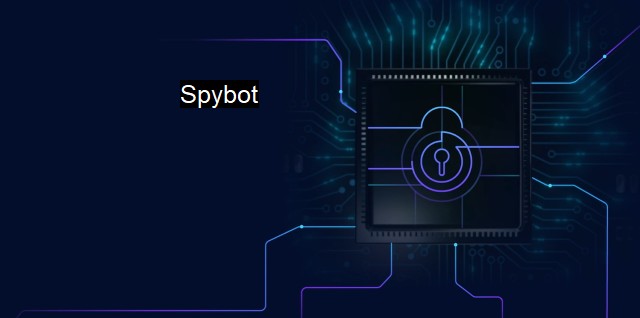What is Spybot?
Defending Against Cyber Threats: Unpacking Spybot's Role in Cybersecurity and Antivirus Protection
Spybot is a renowned cybersecurity and antivirus tool widely used for eliminating different types of malware, adware, and spyware from computing devices. Originated in 2000 and created by German software engineer Patrick Kolla, this software was explicitly designed to uncover and eliminate threats such as risky diallers, key-loggers, Trojans, rootkits, and other harmful software. Over time, Spybot has assumed an authority position among similar cybersecurity software due to its capability to provide essential safety against potential cyber threats.Spybot is subjected to enhancements continuously to maintain its effectiveness against evolving types of malware. This tool minimizes the risk of data breach, illegal data mining, identity theft, and violation of user privacy. Spybot searches and analyzes the computer's hard disk, registry, and virtual memory for harmful and unwanted files, listing suspicions for the user to assess – thus, the name 'Spybot - Search & Destroy.'
One of Spybot’s critical features is its immunization option, offering proactive protection against malware. This process involves blocking the accessibility of known malicious websites, preventing malicious ActiveX downloads, and disabling tracking cookies, consequently reducing the chances of malware attacking the system. This function is especially crucial as it enhances data security before any potential threats can access the user's personal apparatus.
Spybot is also well recognized for its fine-tuning applications. This feature is a handy tool for technically skilled users to optimize system processes, thereby minimizing system lag and general computer operating issues. The software includes advanced sections such as 'Rootkit Scan,' 'System Repair', and 'Secure Shredder,' supplementing Spybot's primary infringement tools.
Regular updates keep the software at the helm of malware detection and removal. Spybot programmers continually add new threat detections to the software's database and improve its algorithms to perceive new, unfamiliar threats. This translates into better protection against zero-day attacks, which involve exploiting computer software vulnerabilities unknown to others or the software creator.
Spybot also has a user-friendly nature, making it applicable for novice and seasoned users. It’s straightforward to install, use, and maintain for many home users, and offers concrete defenses from a variety of cyber threats. Whilst simple, Spybot still provides advanced users with options for deeper system inspections and operations, marrying competence and ease-of-use.
Spybot also contains a boot CD creator feature for emergencies, useful when a virus deactivates a machine entirely. A rescue disc can be a lifeline when facing crippling malware like ransomware. On top of that, it has a function for creating backup registries as cautionary utilities in the event of significant file deletions or computer restorations.
The tool includes a reporting provision, handy for identifying the number and type of threats found during a scan and monitoring previous scan results. There are also advanced setting options for customizing scans, such as dealing with low disk space, setting scan schedules, etc., giving users control over their device's security.
Despite its many advantageous features, Spybot also has some limitations. The lack of a real-time protection mechanism in the free version can serve as a handicap. This function exists in the paid versions, which not all users may prefer. It also requires a substantial amount of system resources during scans, which might lower PCs' performance transitorily.
Another challenge involves compatibility issues with primary antivirus solutions like Windows Defender, since both may attempt to remove the same threats, leading to performance conflicts. To ensure a well-rounded defense strategy, users often run Spybot in conjunction with different antivirus software that exclusively handles more prevalent viruses.
Spybot is a powerful cybersecurity tool, chiefly assisting in preventing infection from malware and spyware. It fills an essential security role particularly effective in enclosing your digital footprint throughout the vast landscape of the internet. This software highlights the exceptional importance of malware protection in the modern digital world, constantly under the risk of having personal data compromised by malicious entities.

Spybot FAQs
What is Spybot?
Spybot is a cybersecurity program that protects your computer from malware, spyware, and adware. It is an antivirus tool that scans your computer for malicious software and removes it from your system.How does Spybot work?
Spybot works by scanning your computer's files and registry for any signs of malicious software. It then quarantines and removes any threats that it finds. It also offers real-time protection, which means it can monitor your system for any suspicious activity and block any potential threats before they can do damage.Is Spybot free?
There are both free and paid versions of Spybot available. The free version offers basic protection and scanning, while the paid version includes additional features such as antivirus protection, real-time scanning, and automatic updates.Can Spybot protect me from all types of cyber threats?
While Spybot can protect your computer from a wide range of cyber threats, it's important to remember that no cybersecurity program can protect you from every possible threat. It's always a good idea to practice safe browsing habits and be cautious when opening emails or downloading files from the internet, even when using antivirus software.| | A | | | B | | | C | | | D | | | E | | | F | | | G | | | H | | | I | | | J | | | K | | | L | | | M | |
| | N | | | O | | | P | | | Q | | | R | | | S | | | T | | | U | | | V | | | W | | | X | | | Y | | | Z | |
| | 1 | | | 2 | | | 3 | | | 4 | | | 7 | | | 8 | | |||||||